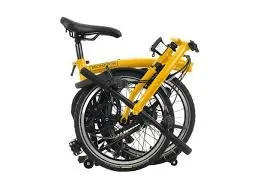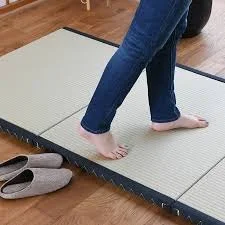Unwanted Foreigners
It was my fourth folding bike tour of Japan. There were 10 people in the group: Eight participants, my daughter and co-leader Nina, and I. We were staying in Kyoto and on this day had cycled from Kyoto to Nara along the Katsura River. We visited the Tōdai-ji Temple, paying our respects to the giant Buddha who sits placidly in the shadows of what for centuries was the largest wooden building in the world. During the tour, we picked our way through swarms of foreign tourists in Tokyo, Kamakura, and now in Kyoto and Nara. Of course, we were also tourists.
It's a longish ride from Kyoto to Nara, about 40 km (24 miles). Some members of the group were less prepared for long-distance cycling – especially on funny folding bikes with 16” wheels – than others. I planned for us to ride to Nara, see the sights, then fold and cover our bikes, and take the Nara Line commuter train back to Kyoto.
Folded Brompton bicycle
The train was crowded, and my group was tired from the long bike ride and from fighting through the crowds in Nara, including the immense herd of tame deer for which the city is famous. I stood next to a tall, powerfully built American guy with a strubbly beard and a large cross on a chain around his neck. A woman and a few children, apparently his family, dozed on the bench seat of the train. The man seemed restless. At one point, he reached up to the handrail that was mounted on the ceiling of the car, grasped it firmly, and began doing chin-ups. He lifted himself up off the floor slowly, methodically, his large feet slightly thrust forward, dangling in the air. It was obvious that this display made passengers on the train uneasy, his enormous shoes floating up and down in midair in a crowded commuter train.
The man was interested in my odd-looking bicycle and inquired about it. We had a short, civil conversation, and that’s how I confirmed the obvious: this guy is an American.
Calisthenics on a commuter train: Was he showing off? Or simply bored? Was he trying to be offensive?
His intentions were probably innocent enough. He may have failed to observe that no one else was using a commuter train as a gym. He may not have noticed that the local passengers were not even talking on the train. Maybe the fellow simply needed a workout and that handrail was just the ticket to pump his muscles a bit.
On another day, we visited the Fushimi Inari Taisha Shrine in southeast Kyoto. The shrine, with its nearly 10,000 torii vermillion gates, is immensely popular with tourists. In fact, walking up the mountainside through the first several thousand gates can be a daunting exercise, more like negotiating crowds of commuters at one of the world’s busiest train stations than a visit to a place sacred to Japan’s native religion, Shintō. I found the place exhausting.
I rested near the entrance to the shrine as the other members of the group finished their visit. This is where I saw a young Western woman wearing a rental yukata (she probably believed it was a full-dress kimono) as she strode around in hiking boots. I snapped her picture.
Seen at the Inari Fushimi
Shrine, Kyoto
These boots are made for walking
For several years, the Japanese yen has been weaker against the dollar, the euro, and other currencies than it has been for decades. Japan’s inflation rate remains low. Word has gotten out around the world that Japan is a bargain travel destination. Statistics about the growth of inbound tourism into Japan are easy to find online, but the massive upsurge in foreign tourists in the country is plain to see. Although the Japanese government has promoted inbound tourism for years, they could not have imagined how successful they would be at attracting foreigners to the country. As in most things, be careful what you ask for: You might get what you ask for.
What Japan has gotten is a problem for residents of major tourist destinations like Tokyo, Kyoto, Kamaura, Hiroshima, and many other locations throughout the country. There is a new word for the problem: kankō osen (観光汚染) “tourism pollution,” in other words, over-tourism. Like some non-native water plant brought in to ornament a pond – “seemed like a good idea at the time!” – tourism has grown and spread like some hideous invasive species, upsetting the daily routines of local residents and turning familiar streets into obstacle courses blocked by hordes of selfie-snapping tourists.
For example, there is the ongoing assault on maiko (舞妓), young apprentice geisha. Granted, the traditional kimono (着物) and intricate nihongami (日本髪) hairdos of these high class entertainers-in-training, make maiko quite photogenic. But tourist paparazzi often take things to truly offensive extremes, as in this scene captured in Kyoto’s Gion district: https://www.youtube.com/shorts/jxEKRNW2rXk
OK, I get it: You’ve saved up for years, flown a bazillion hours from your country to Japan, and there in Kyoto is a gen-u-wine geisha, or maiko, or whatever. Gotta get a picture of that!
To me, it is icky to snap the picture of someone which includes their face without that person’s consent. It’s a form of assault. To prevent these disruptions, the Gion South District Council (祇園南側地区協議会) has closed off certain streets frequented by geisha and maiko to outsiders, with a ¥10,000 ($66) fine for violations.
The sign is more specific in Japanese: “This is a private street. No entry for tourists or guided photography tours.”
* * * * *
In the most recent parliamentary elections, the ruling Liberal Democratic Party (LDP; neither liberal nor notably democratic) maintained its 70-year-old iron grip on power. This time, however, the party has taken a decided turn to the right, choosing as its standard-bearer a protégé of the late Shinzō Abe and a fervent admirer of Margaret Thatcher, Japan’s first female prime minister, Sanae Takaichi. And many Japanese voters have thrown their lot in with a new hard-right, MAGA look-alike party called the Sansei-tō (参政党; “Political Participation Party”), with its overtly anti-foreigner platform and demagogic appeal to disaffected voters. Japan’s drift to the right tracks with trends throughout the developed world. People everywhere fear “the other,” people who do not look like themselves, who do not speak their language, who do not follow their customs.
I hear a common theme in conversations with my friends: they welcome foreign visitors to Japan as well as new immigrants, as long as they follow the rules. All societies have rules, and a densely packed society like Japan probably has more rules than other countries. Don’t wear street shoes in living spaces. Don’t walk around while eating your lunch. Don’t do calisthenics on the train.
I have now led five tours to Japan, a total of 32 people, including participants from the U.S., Canada, and New Zealand. Perhaps my tours contribute to Japan’s over-tourism. If so, I am sorry. But I do make a point of informing my groups about the basic rules. I’ve had to shush voluble talkers on the trains. I’ve reminded people where shoes are to be worn and not worn. I’ve painstakingly reviewed public bath procedures. I’ve explained that restaurants generally do not permit substitutions. I’ve asked people not to sit on dirty curbstones in the street. To a visitor from a more freewheeling society like the U.S., Japan can seem like a minefield of no-no’s.
All the same, I would prefer the people I escort through Japan to put their best foot forward….and please, no shoes, slippers, only socks or bare feet on the tatami mats!
Tread softly…



